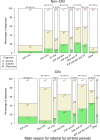The effectiveness of schemes that refine referrals between primary and secondary care--the UK experience with glaucoma referrals: the Health Innovation & Education Cluster (HIEC) Glaucoma Pathways Project
- PMID: 23878172
- PMCID: PMC3717451
- DOI: 10.1136/bmjopen-2013-002715
The effectiveness of schemes that refine referrals between primary and secondary care--the UK experience with glaucoma referrals: the Health Innovation & Education Cluster (HIEC) Glaucoma Pathways Project
Abstract
Objectives: A comparison of glaucoma referral refinement schemes (GRRS) in the UK during a time period of considerable change in national policy and guidance.
Design: Retrospective multisite review.
Setting: The outcomes of clinical examinations by optometrists with a specialist interest in glaucoma (OSIs) were compared with optometrists with no specialist interest in glaucoma (non-OSIs). Data from Huntingdon and Nottingham assessed non-OSI findings, while Manchester and Gloucestershire reviewed OSI findings.
Participants: 1086 patients. 434 patients were from Huntingdon, 179 from Manchester, 204 from Gloucestershire and 269 from Nottingham.
Results: The first-visit discharge rate (FVDR) for all time periods for OSIs was 14.1% compared with 36.1% from non-OSIs (difference 22%, CI 16.9% to 26.7%; p<0.001). The FVDR increased after the April 2009 National Institute for Health and Clinical Excellence (NICE) glaucoma guidelines compared with pre-NICE, which was particularly evident when pre-NICE was compared with the current practice time period (OSIs 6.2-17.2%, difference 11%, CI -24.7% to 4.3%; p=0.18, non-OSIs 29.2-43.9%, difference 14.7%, CI -27.8% to -0.30%; p=0.03). Elevated intraocular pressure (IOP) was the commonest reason for referral for OSIs and non-OSIs, 28.7% and 36.1%, respectively, of total referrals. The proportion of referrals for elevated IOP increased from 10.9% pre-NICE to 28.0% post-NICE for OSIs, and from 19% to 45.1% for non-OSIs.
Conclusions: In terms of 'demand management', OSIs can reduce FVDR of patients reviewed in secondary care; however, in terms of 'patient safety' this study also shows that overemphasis on IOP as a criterion for referral is having an adverse effect on both the non-OSIs and indeed the OSIs ability to detect glaucomatous optic nerve features. It is recommended that referral letters from non-OSIs be stratified for risk, directing high-risk patients straight to secondary care, and low-risk patients to OSIs.
Figures


References
-
- Davey CJ, Green C, Elliott DB. Assessment of referrals to the hospital eye service by optometrists and GPs in Bradford and Airedale. Ophthalmic Physiol Opt 2011;31:23–8 - PubMed
-
- Burr JM, Mowatt G, Hernández R, et al. The clinical effectiveness and cost-effectiveness of screening for open angle glaucoma: a systematic review and economic evaluation. Health Technol Assess 2007;11:1–190 - PubMed
LinkOut - more resources
Full Text Sources
Other Literature Sources
Miscellaneous
